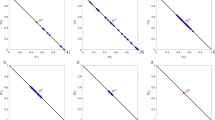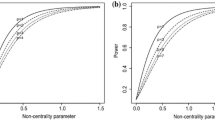Abstract
In this paper we derive the asymptotic distributions of the estimated weights and of estimated performance measures of the minimum value-at-risk portfolio and of the minimum conditional value-at-risk portfolio assuming that the asset returns follow a strictly stationary process. It is proved that the estimated weights as well as the estimated performance measures are asymptotically multivariate normally distributed. We also present an asymptotic test for the weights and a joint test for the characteristics of both portfolios. Moreover, the asymptotic densities of the estimated performance measures are compared with the corresponding exact densities. It is shown that the asymptotic approximation performs well even for the moderate sample size.






Similar content being viewed by others
References
Adcock CJ (2010) Asset pricing and portfolio selection based on the multivariate extended skew-student-t distribution. Ann Oper Res 176:221–234
Alexander GJ, Baptista MA (2002) Economic implication of using a mean-VaR model for portfolio selection: a comparison with mean-variance analysis. J Econ Dyn Control 26:1159–1193
Alexander GJ, Baptista MA (2004) A comparison of VaR and CVaR constraints on portfolio selection with the mean-variance model. Manag Sci 50:1261–1273
Artzner P, Delbaen F, Eber JM, Heath D (1999) Coherent measures of risk. Math Finance 9:203–228
Basak GK, Jagannathan R, Ma T (2009) Jackknife estimator for tracking error variance of optimal portfolios. Manag Sci 55:990–1002
Benati S (2003) The optimal portfolio problem with coherent risk measure constraints. Eur J Oper Res 150:572–584
Blattberg RC, Gonedes NJ (1974) A comparison of the stable and student distributions as statistical models for stock prices. J Bus 47:244–280
Bodnar T, Schmid W (2008) Estimation of optimal portfolio compositions for gaussian returns. Stat Decis 26:179–201
Bodnar T, Schmid W (2009) Econometrical analysis of the sample efficient frontier. Eur J Finance 15:317–335
Bodnar T, Schmid W, Zabolotskyy T (2009) Statistical inference of the efficient frontier for dependent asset returns. Stat Pap 50:593–604
Bodnar T, Schmid W, Zabolotskyy T (2012) Minimum VaR and minimum CVaR optimal portfolios: estimators, confidence regions, and tests. Stat Risk Model 29:281–314
Brillinger DR (1981) Time series: data analysis and theory. Holden Day, San Francisco
Britten-Jones M (1999) The sampling error in estimates of mean-variance efficient portfolio weights. J Finance 54:655–671
Brockwell PJ, Davis RA (1991) Time series: theory and methods. Springer, New York
Campbell R, Huisman R, Koedijk K (2001) Optimal portfolio selection in a value-at-risk framework. J Banking Finance 25:1789–1804
Embrechts P, Klüppelberg S, Mikosch T (1997) Modelling extremal events for insurance and finance. Springer, Berlin
Fang K-T, Zhang Y-T (1990) Generalized multivariate analysis. Springer/Science Press, Berlin/Beijing
Frahm G, Memmel C (2010) Dominating estimators for the global minimum variance portfolio. J Econ 159:289–302
Gibbons MR, Ross SA, Shanken J (1989) A test of the efficiency of a given portfolio. Econometrica 57:1121–1152
Gupta AK, Varga T (1993) Elliptically contoured models in statistics. Kluwer, Dordrecht
Hannan EJ (1970) Multiple time series. Wiley, New York
Harvey CR, Liechty JC, Liechty MW, Müller P (2010) Portfolio selection with higher moments. Quant Finance 10:469–485
Harville DA (1997) Matrix algebra from a statistician’s perspective. Springer, New York
Jobson JD, Korkie B (1980) Estimation of Markowitz efficient portfolios. J Am Stat Assoc 75:544–554
Jondeau E, Rockinger M (2006) Optimal portfolio allocation under higher moments. Eur Financ Manag 12:29–55
Krokhmal P (2007) Higher moment risk measures. Quant Finance 7:373–387
Lim C, Sherali H, Uryasev S (2010) Portfolio optimization by minimizing conditional value-at-risk via nondifferentiable optimization. Comput Optim Appl 46:391–415
Magnus JR, Neudecker H (2007) Matrix differential calculus with applications in statistics and econometrics. Wiley, New York
Markowitz H (1952) Portfolio selection. J Finance 7:77–91
Mencia J, Sentana E (2009) Multivariate location-scale mixtures of normals and mean-variance-skewness portfolio allocation. J Econ 153:105–121
Merton RC (1972) An analytical derivation of the efficient frontier. J Financ Quant Anal 7:1851–1872
Muirhead RJ (1982) Aspects of multivariate statistical theory. Wiley, New York
Okhrin Y, Schmid W (2006) Distributional properties of optimal portfolio weights. J Econ 134:235–256
Patton AJ (2004) On the out-of-sample importance of skewness and asymmetric dependence for asset allocation. J Financ Econ 2:130–168
Rockafellar RT, Uryasev S (2000) Optimization of conditional value-at-risk. J Risk 2:21–41
Rockafellar RT, Uryasev S (2002) Conditional value-at-risk for general loss distribution. J Banking Finance 26:1443–1471
Schmid W, Zabolotskyy T (2008) On the existence of unbiased estimators for the portfolio weights. Adv Stat Anal 92:29–34
Acknowledgments
The authors are thankful to the Editor and the two anonymous Referees for careful reading of the paper and for their suggestions which have improved an earlier version of this paper.
Author information
Authors and Affiliations
Corresponding author
Appendix
Appendix
In this section, the proofs of the theorems are given. First, we formulate an important lemma which is used for proving Theorems 1 and 2. This lemma extends the asymptotic results of Bodnar et al. (2009) obtained for a gaussian process to an arbitrary strictly stationary process.
Lemma 1
Let \(\{ \mathbf{X }_t \}\) be a strictly stationary process with mean \({\varvec{\mu }}\) and cross-covariance matrix \({\varvec{\Gamma }}(h)\) at lag \(h\). We assume that the infinite sum in (14) converges. Then it follows that
where
with
Proof of Lemma 1
The proofs of Lemma 1 follows from the proof of Theorem 1 of Bodnar et al. (2009) and the statement that \({\hat{\varvec{\theta }}}=({\hat{\varvec{\mu }}}^\prime , {\text{ vech}}(\hat{\varvec{\Gamma }}(0))^\prime )^\prime \) is asymptotically normally distributed with mean vector \({\varvec{\theta }}\) and covariance matrix \({\varvec{\Omega }}/n\) (cf. (Brillinger (1981), Theorem 4.4.1)).
Proof of Theorem 1
It follows that
where
and
Next, we calculate \(\partial s /\partial ({\text{ vech}}{\varvec{\Gamma }}(0))\) and \(\partial \mathbf{w }^{\prime }_{VaR}/\partial ({\text{ vech}}{\varvec{\Gamma }}(0))\). For this calculation the following identities are applied
Hence,
and
The substitution of the above calculated derivatives leads to
where \(a_1,\,a_2,\,\mathbf{v }_1,\,\mathbf{v }_2\), and \(\mathbf{v }_3\) are given in (16).
It completes the proof of Theorem 1.
Proof of Corollary 1
We get
where \(B_n=\{ -\sqrt{n}s<\sqrt{n}(\hat{s}-s)<\sqrt{n}(d^2_{\alpha }-s)\}\) is an increasing sequence of intervals with \(\bigcup _{n=1}^\infty B_n =\Omega \). Moreover, it holds that
and
The application of the continuity property of the probability leads to \(\lim _{n \rightarrow \infty } P(B_n)=P\left( \bigcup _{n=1}^\infty B_n\right) =1\) and
and consequently
which is the marginal distribution of \(\sqrt{n}(\hat{\mathbf{w }}_{VaR}-\mathbf{w }_{VaR})\). Hence, \(\sqrt{n}(\hat{\mathbf{w }}_{VaR}-\mathbf{w }_{VaR})\) given \(0<\hat{s}<d^2_{\alpha }\) is asymptotically multivariate normally distributed with zero mean vector and covariance matrix \({\varvec{S}}_{11}\). The corollary is proved.
Proof of Theorem 2
-
(a)
Lemma 1 proves that
$$\begin{aligned} \sqrt{n}\left( \left( \hat{R}_{GMV},\hat{V}_{GMV},\hat{s}\right) ^{\prime }-(R_{GMV},V_{GMV},s)^{\prime }\right) \stackrel{d}{\rightarrow }\mathcal N (\mathbf 0 ,{\varvec{\Omega }}_{EF}). \end{aligned}$$Thus,
$$\begin{aligned} \sqrt{n}\left( \left( \hat{R}_{VaR},\hat{V}_{VaR},\hat{s}\right) ^\prime -(R_{VaR},V_{VaR},s)^\prime \right) \stackrel{d}{\rightarrow }\mathcal N (\mathbf 0 ,{\varvec{\Omega }}_{RVs}) \end{aligned}$$with \({\varvec{\Omega }}_{RVs}=\mathbf{G }_1 {\varvec{\Omega }}_{EF}\mathbf{G }_1^\prime \) where
$$\begin{aligned} \mathbf{G }_1=\left( \begin{array}{ccc} \partial R_{VaR}/\partial R_{GMV}&{} \partial R_{VaR}/\partial V_{GMV} &{} \partial R_{VaR}/\partial s \\ \partial V_{VaR}/\partial R_{GMV} &{} \partial V_{VaR}/\partial V_{GMV} &{} \partial V_{VaR}/\partial s \\ \partial s/\partial R_{GMV} &{} \partial s/\partial V_{GMV} &{} \partial s/\partial s\\ \end{array} \right) \end{aligned}$$$$\begin{aligned} \mathbf{G }_1=\left( \begin{array}{ccc} 1 &{} \frac{1}{2\sqrt{V_{GMV}}}\frac{s}{\sqrt{d_{1-\alpha }^2-s}} &{} \frac{2d_{1-\alpha }^2-s}{2\left( d_{1-\alpha }^2-s\right) ^{3/2}}\sqrt{V_{GMV}} \\ 0 &{} \frac{d_{1-\alpha }^2}{d_{1-\alpha }^2-s} &{} \frac{d_{1-\alpha }^2}{\left( d_{1-\alpha }^2-s\right) ^2}V_{GMV} \\ 0 &{} 0 &{} 1\\ \end{array} \right) \end{aligned}$$Hence,
$$\begin{aligned} \mathbf{G }_1{\varvec{\Omega }}_{EF}\mathbf{G }_1^{\prime }&= \left( \begin{array}{ccc} 1 &{} \frac{1}{2\sqrt{V_{GMV}}}\frac{s}{\sqrt{d_{1-\alpha }^2-s}} &{} \frac{2d_{1-\alpha }^2-s}{2\left( d_{1-\alpha }^2-s\right) ^{3/2}}\sqrt{V_{GMV}} \\ 0 &{} \frac{d_{1-\alpha }^2}{d_{1-\alpha }^2-s} &{} \frac{d_{1-\alpha }^2}{\left( d_{1-\alpha }^2-s\right) ^2}V_{GMV} \\ 0 &{} 0 &{} 1\\ \end{array} \right) \times \left( \begin{array}{ccc} \sigma _1^2 &{} \sigma _{12} &{} \sigma _{13} \\ \sigma _{12} &{} \sigma _2^2 &{} \sigma _{23} \\ \sigma _{13} &{} \sigma _{23} &{} \sigma _3^2 \\ \end{array} \right) \\&\times \left( \begin{array}{ccc} 1 &{} 0 &{} 0\\ \frac{1}{2\sqrt{V_{GMV}}}\frac{s}{\sqrt{d_{1-\alpha }^2-s}} &{} \frac{d_{1-\alpha }^2}{d_{1-\alpha }^2-s} &{} 0\\ \frac{2d_{1-\alpha }^2-s}{2\left( d_{1-\alpha }^2-s\right) ^{3/2}}\sqrt{V_{GMV}} &{} \frac{d_{1-\alpha }^2}{\left( d_{1-\alpha }^2-s\right) ^2}V_{GMV} &{} 1 \\ \end{array} \right) =\left( \begin{array}{ccc} \tilde{\sigma }_1^2 &{} \tilde{\sigma }_{12} &{} \tilde{\sigma }_{13}\\ \tilde{\sigma }_{12} &{} \tilde{\sigma }_2^2 &{} \tilde{\sigma }_{23}\\ \tilde{\sigma }_{13} &{} \tilde{\sigma }_{23} &{} \tilde{\sigma }_3^2\\ \end{array} \right) \!, \end{aligned}$$where
$$\begin{aligned} \tilde{\sigma }_1^2&= \sigma _1^2+2\sigma _{12}\frac{1}{2\sqrt{V_{GMV}}}\frac{s}{\sqrt{d_{1-\alpha }^2-s}}\\&+2\sigma _{13}\frac{2d_{1-\alpha }^2-s}{2\left( d_{1-\alpha }^2-s\right) ^{3/2}} \sqrt{V_{GMV}}+\sigma _2^2\frac{1}{4V_{GMV}}\frac{s^2}{d_{1-\alpha }^2-s}\\&+2\sigma _{23}\frac{s\left( 2d_{1-\alpha }^2-s\right) }{4\left( d_{1-\alpha }^2-s\right) ^2}+ \sigma _3^2\frac{\left( 2d_{1-\alpha }^2-s\right) ^2}{4\left( d_{1-\alpha }^2-s\right) ^3}V_{GMV}\,,\\ \tilde{\sigma }_{12}&= \sigma _{12}\frac{d_{1-\alpha }^2}{d_{1-\alpha }^2-s}+\sigma _2^2\frac{1}{2\sqrt{V_{GMV}}}\frac{sd_{1-\alpha }^2}{\left( d_{1-\alpha }^2-s\right) ^{3/2}}+\sigma _{13}\frac{d_{1-\alpha }^2}{\left( d_{1-\alpha }^2-s\right) ^2}V_{GMV} \\&+\sigma _{23}\left( \frac{d_{1-\alpha }^2\left( 2d_{1-\alpha }^2-s\right) }{2\left( d_{1-\alpha }^2-s\right) ^{5/2}}\sqrt{V_{GMV}}+\frac{sd_{1-\alpha }^2}{2\left( d_{1-\alpha }^2-s\right) ^{5/2}}\sqrt{V_{GMV}}\right) \\&+\sigma _3^2\frac{d_{1-\alpha }^2\left( 2d_{1-\alpha }^2-s\right) }{2\left( d_{1-\alpha }^2-s\right) ^{7/2}}V_{GMV}^{3/2}=\sigma _{12}\frac{d_{1-\alpha }^2}{d_{1-\alpha }^2-s}\\&+\sigma _2^2\frac{1}{2\sqrt{V_{GMV}}}\frac{sd_{1-\alpha }^2}{\left( d_{1-\alpha }^2-s\right) ^{3/2}}+ \sigma _{23}\frac{d_{1-\alpha }^4}{\left( d_{1-\alpha }^2-s\right) ^{5/2}}\sqrt{V_{GMV}}\\&+\sigma _{13}\frac{d_{1-\alpha }^2}{\left( d_{1-\alpha }^2-s\right) ^2}V_{GMV}+\sigma _3^2\frac{d_{1-\alpha }^2\left( 2d_{1-\alpha }^2-s\right) }{2\left( d_{1-\alpha }^2-s\right) ^{7/2}}V_{GMV}^{3/2}\,,\\ \tilde{\sigma }_{13}&= \sigma _{13}+\sigma _{23}\frac{1}{2\sqrt{V_{GMV}}}\frac{s}{\sqrt{d_{1-\alpha }^2-s}}+ \sigma _3^2\frac{2d_{1-\alpha }^2-s}{2\left( d_{1-\alpha }^2-s\right) ^{3/2}}\sqrt{V_{GMV}}\,,\\ \tilde{\sigma }_2^2&= \sigma _2^2\frac{d_{1-\alpha }^4}{\left( d_{1-\alpha }^2-s\right) ^2}+2\sigma _{23}\frac{d_{1-\alpha }^4}{\left( d_{1-\alpha }^2-s\right) ^3}V_{GMV}+ \sigma _3^2\frac{d_{1-\alpha }^4}{\left( d_{1-\alpha }^2-s\right) ^4}V_{GMV}^2\,,\\ \tilde{\sigma }_{23}&= \sigma _{23}\frac{d_{1-\alpha }^2}{d_{1-\alpha }^2-s}+ \sigma _3^2\frac{d_{1-\alpha }^2}{\left( d_{1-\alpha }^2-s\right) ^2}V_{GMV}\,,\\ \tilde{\sigma }_3^2&= \sigma _3^2 \,. \end{aligned}$$
-
(b)
The proof of part (b) is similar to the proof of part (a). It holds that
$$\begin{aligned}&\sqrt{n}\left( \left( \hat{R}_{VaR},\hat{M}_{VaR},\hat{s}\right) ^\prime -(R_{VaR},M_{VaR},s)^\prime \right) \stackrel{d}{\rightarrow }\mathcal N (\mathbf 0 ,{\varvec{\Omega }}_{RMs})\\&\quad =\mathcal N (\mathbf 0 ,\mathbf{G }_1 {\varvec{\Omega }}_{EF}\mathbf{G }_1^\prime )\,, \end{aligned}$$where
$$\begin{aligned} \mathbf{G }_2&= \left( \begin{array}{ccc} \partial R_{VaR}/\partial R_{GMV}&{} \partial R_{VaR}/\partial V_{GMV} &{} \partial R_{VaR}/\partial s \\ \partial M_{VaR}/\partial R_{GMV} &{} \partial M_{VaR}/\partial V_{GMV} &{} \partial M_{VaR}/\partial s \\ \partial s/\partial R_{GMV} &{} \partial s/\partial V_{GMV} &{} \partial s/\partial s\\ \end{array} \right) \\&= \left( \begin{array}{ccc} 1 &{} \frac{1}{2\sqrt{V_{GMV}}}\frac{s}{\sqrt{d_{1-\alpha }^2-s}} &{} \frac{2d_{1-\alpha }^2-s}{2\left( d_{1-\alpha }^2-s\right) ^{3/2}}\sqrt{V_{GMV}} \\ -1 &{} \frac{1}{2\sqrt{V_{GMV}}}\sqrt{d_{1-\alpha }^2-s} &{} -\frac{1}{2\sqrt{d_{1-\alpha }^2-s}}\sqrt{V_{GMV}} \\ 0 &{} 0 &{} 1\\ \end{array} \right) \end{aligned}$$Hence,
$$\begin{aligned} \mathbf{G }_2{\varvec{\Omega }}_{EF}\mathbf{G }_2^{\prime }&= \left( \begin{array}{ccc} 1 &{} \frac{1}{2\sqrt{V_{GMV}}}\frac{s}{\sqrt{d_{1-\alpha }^2-s}} &{} \frac{2d_{1-\alpha }^2-s}{2\left( d_{1-\alpha }^2-s\right) ^{3/2}}\sqrt{V_{GMV}} \\ -1 &{} \frac{1}{2\sqrt{V_{GMV}}}\sqrt{d_{1-\alpha }^2-s} &{} -\frac{1}{2\sqrt{d_{1-\alpha }^2-s}}\sqrt{V_{GMV}} \\ 0 &{} 0 &{} 1\\ \end{array} \right) \times \left( \begin{array}{ccc} \sigma _1^2 &{} \sigma _{12} &{} \sigma _{13} \\ \sigma _{12} &{} \sigma _2^2 &{} \sigma _{23} \\ \sigma _{13} &{} \sigma _{23} &{} \sigma _3^2 \\ \end{array} \right) \\&\times \left( \begin{array}{ccc} 1 &{} -1 &{} 0\\ \frac{1}{2\sqrt{V_{GMV}}}\frac{s}{\sqrt{d_{1-\alpha }^2-s}} &{} \frac{1}{2\sqrt{V_{GMV}}}\sqrt{d_{1-\alpha }^2-s}&{}0\\ \frac{2d_{1-\alpha }^2-s}{2(d_{1-\alpha }^2-s)^{3/2}}\sqrt{V_{GMV}} &{} -\frac{1}{2\sqrt{d_{1-\alpha }^2-s}}\sqrt{V_{GMV}}&{}1\\ \end{array} \right) = \left( \begin{array}{ccc} \breve{\sigma }_1^2 &{} \breve{\sigma }_{12} &{} \breve{\sigma }_{13}\\ \breve{\sigma }_{12} &{} \breve{\sigma }_2^2 &{} \breve{\sigma }_{23}\\ \breve{\sigma }_{13} &{} \breve{\sigma }_{23} &{} \breve{\sigma }_3^2\\ \end{array} \right) \!, \end{aligned}$$where
$$\begin{aligned} \breve{\sigma }_1^2&= \tilde{\sigma }_1^2=\sigma _1^2+2\sigma _{12}\frac{1}{2\sqrt{V_{GMV}}}\frac{s}{\sqrt{d_{1-\alpha }^2-s}}+2\sigma _{13}\frac{2d_{1-\alpha }^2-s}{2(d_{1-\alpha }^2-s)^{3/2}} \sqrt{V_{GMV}}\\&+\sigma _2^2\frac{1}{4V_{GMV}}\frac{s^2}{d_{1-\alpha }^2-s}+2\sigma _{23}\frac{s\left( 2d_{1-\alpha }^2-s\right) }{4(d_{1-\alpha }^2-s)^2}+ \sigma _3^2\frac{\left( 2d_{1-\alpha }^2-s\right) ^2}{4\left( d_{1-\alpha }^2-s\right) ^3}V_{GMV}\,,\\ \breve{\sigma }_{12}&= -\sigma _1^2+\sigma _2^2\frac{s}{4V_{GMV}}-\sigma _3^2\frac{2d_{1-\alpha }^2-s}{4\left( d_{1-\alpha }^2-s\right) ^2}V_{GMV} +\sigma _{12}\frac{1}{2\sqrt{V_{GMV}}}\frac{d_{1-\alpha }^2-2s}{\sqrt{d_{1-\alpha }^2-s}}\\&-\sigma _{13}\frac{3d_{1-\alpha }^2-2s}{2\left( d_{1-\alpha }^2-s\right) ^{3/2}}\sqrt{V_{GMV}}+\sigma _{23}\frac{1}{2}\,,\\ \breve{\sigma }_{13}&= \sigma _{13}+\sigma _{23}\frac{1}{2\sqrt{V_{GMV}}}\frac{s}{\sqrt{d_{1-\alpha }^2-s}}+ \sigma _3^2\frac{2d_{1-\alpha }^2-s}{2\left( d_{1-\alpha }^2-s\right) ^{3/2}}\sqrt{V_{GMV}}\,,\\ \breve{\sigma }_2^2&= \sigma _1^2-2\sigma _{12}\frac{1}{2\sqrt{V_{GMV}}}\sqrt{d_{1-\alpha }^2-s}+ 2\sigma _{13}\frac{1}{2\sqrt{d_{1-\alpha }^2-s}}\sqrt{V_{GMV}}\\&+\sigma _2^2\frac{1}{4V_{GMV}}\left( d_{1-\alpha }^2-s\right) -2\sigma _{23}\frac{1}{4}+\sigma _3^2\frac{1}{4\left( d_{1-\alpha }^2-s\right) }V_{GMV}\,,\\&-2\sigma _{23}\frac{1}{4}+\sigma _3^2\frac{1}{4\left( d_{1-\alpha }^2-s\right) }V_{GMV}\,,\\ \breve{\sigma }_{23}&= -\sigma _{13}+\sigma _{23}\frac{1}{2\sqrt{V_{GMV}}}\sqrt{d_{1-\alpha }^2-s}-\sigma _3^2\frac{1}{2\sqrt{d_{1-\alpha }^2-s}}\sqrt{V_{GMV}}\,,\\ \breve{\sigma }_3^2&= \sigma _3^2\,. \end{aligned}$$
Rights and permissions
About this article
Cite this article
Bodnar, T., Schmid, W. & Zabolotskyy, T. Asymptotic behavior of the estimated weights and of the estimated performance measures of the minimum VaR and the minimum CVaR optimal portfolios for dependent data. Metrika 76, 1105–1134 (2013). https://doi.org/10.1007/s00184-013-0432-1
Received:
Published:
Issue Date:
DOI: https://doi.org/10.1007/s00184-013-0432-1




